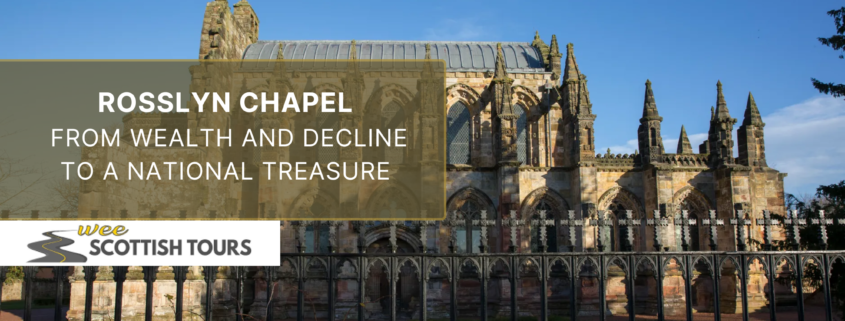Rosslyn Chapel: From Wealth and Decline to a National Treasure
Rosslyn Chapel is a place where myth, mystery, and magnificence meet. From its prosperous beginnings in the 15th century to its near ruin and rise to international fame, this iconic site just south of Edinburgh has a story unlike any other.
The Global Spotlight: Enter The Da Vinci Code
Rosslyn Chapel gained global recognition in 2006 thanks to The Da Vinci Code film adaptation. Nearly all interior scenes were filmed on location, with stars Tom Hanks and Audrey Tautou spending several days there. Hanks described the experience as, “Few film locations are as charming and few places fulfill their promise, but Rosslyn Chapel was everything one might envision or wish for.”
Following the 2003 release of Dan Brown’s bestseller and the movie’s success, Rosslyn Chapel saw a massive increase in tourism. At its peak, over 176,000 visitors flocked to the site annually. This surge provided the funding needed for extensive conservation work—preserving the chapel’s unique architecture and storied charm.
Where It All Began: A Vision in Stone
Our story starts in 1446, when William St Clair, the third Prince of Orkney, began constructing what would become the Collegiate Chapel of St Matthew. Completed around 1450, the chapel served as a religious center for St Clair’s family and employees.
Collegiate chapels were meant to spread both spiritual and intellectual enlightenment. Rosslyn’s detailed stonework and ambitious design made it a masterpiece of craftsmanship. Though St Clair likely had plans for a grander cruciform structure, his death in 1484 halted further construction.

William St Clair, third Prince of Orkney and the visionary behind Rosslyn Chapel, as depicted in a historical illustration.
Centuries of Decline and Neglect
The Reformation brought hard times. In 1571, Rosslyn’s clergy resigned, and by 1592, the altars were destroyed on royal orders. The chapel was no longer used for worship, beginning centuries of neglect.
In 1650, Oliver Cromwell’s troops looted nearby Rosslyn Castle and used the chapel as a stable. That same year, Sir William Sinclair died at the Battle of Dunbar and was laid to rest in full armor beneath the chapel—believed to be the last knight interred there.
In 1736, Sir James Sinclair began some minor restoration, installing glass windows and repairing the floor—marking the chapel’s first real care in over 150 years.
A Muse for Artists and Royals
The 18th and 19th centuries saw Rosslyn transform into a romantic ruin. Poets like Robert Burns and artists such as Alexander Nasmyth visited and were inspired by its eerie charm. Sir Walter Scott immortalized the chapel in his poem Lay of the Last Minstrel, depicting it glowing at the death of a Rosslyn baron.
In 1842, Queen Victoria visited and proclaimed it should be “saved for the nation.” Restoration followed, led by architect David Bryce. The chapel was rededicated and once again hosted Sunday services for the first time in centuries.
Restoration, Recognition, and Renewal
The 20th century brought continued use—and much-needed repairs. From intricate ceiling carvings to weather-worn walls, every element received care. The Rosslyn Chapel Trust was founded in 1995 to ensure ongoing preservation.
With the success of The Da Vinci Code, Rosslyn entered the international spotlight once more. In 2007, nearly £5 million in grant funding supported further restoration. By 2012, the project was complete, celebrated with a service attended by Her Royal Highness The Duchess of Rothesay and the opening of a new Visitor Centre.
Conclusion: A Timeless Treasure
Rosslyn Chapel has endured war, neglect, and the passage of centuries. Thanks to historical stewardship and a little help from Hollywood, this architectural gem has been preserved for future generations.
If you haven’t yet visited, make the trip just south of Edinburgh. Rosslyn Chapel’s mysteries, history, and beauty await you.





